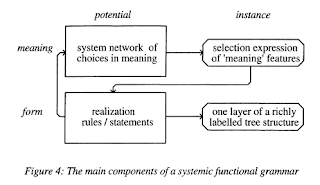Fawcett (2010: 104):
One might expect, in principle, that it would be sufficient to characterise the 'form potential', and that the theory required to describe the instances would follow automatically from this — and if this was so the approach taken in "Systemic theory" would be justified. But in practice this does not provide the framework of concepts that is required in the applications to which a model of language is put. In other words, it is not enough to model language in its generative mode (or 'at rest'); the theory must supply the concepts that are required for modelling the use of language in both the generation and the analysis of text-sentences — and it must do this for each level of language that is recognised in the theory.
Blogger Comments:
[1] This is misleading. This presents Fawcett's model, Figure 4, as if it represents the architecture of SFL Theory. By 'form potential' Fawcett means realisation rules (divorced from system networks), and by 'instances' Fawcett means syntagmatic structures (rather than instances).
[2] This is misleading. "Systemic theory" (Halliday 1993) is merely a brief article in an encyclopædia that sets out in 3 pages the history, basic concepts, and development of Systemic Theory, written for readers of encyclopædias, rather than an academic publication for scholars seeking a deep understanding of the theory. Fawcett's complaint is that a 3-page summary does not set out the theory in all its complexity.
[3] This is misleading. The systems and realisation statements that specify grammatical structures are set out in Lexicogrammatical Cartography (Matthiessen 1995), with some also incorporated in the third (and fourth) editions of IFG (Halliday & Matthiessen 2004 (and 2014)). The grammatical structures that realise these systems are set out in all editions of IFG.
[4] To be clear, Fawcett's compliance with this stipulation amounts to splitting one level of abstraction (systems and their realisation rules) into two levels (meaning and form), in the case of the left-hand column of Figure 4, and misunderstanding selection expressions and syntagmatic structure as instances, in the case of the right-hand column of Figure 4.
[2] This is misleading. "Systemic theory" (Halliday 1993) is merely a brief article in an encyclopædia that sets out in 3 pages the history, basic concepts, and development of Systemic Theory, written for readers of encyclopædias, rather than an academic publication for scholars seeking a deep understanding of the theory. Fawcett's complaint is that a 3-page summary does not set out the theory in all its complexity.
[3] This is misleading. The systems and realisation statements that specify grammatical structures are set out in Lexicogrammatical Cartography (Matthiessen 1995), with some also incorporated in the third (and fourth) editions of IFG (Halliday & Matthiessen 2004 (and 2014)). The grammatical structures that realise these systems are set out in all editions of IFG.
[4] To be clear, Fawcett's compliance with this stipulation amounts to splitting one level of abstraction (systems and their realisation rules) into two levels (meaning and form), in the case of the left-hand column of Figure 4, and misunderstanding selection expressions and syntagmatic structure as instances, in the case of the right-hand column of Figure 4.

No comments:
Post a Comment